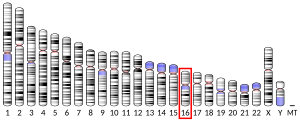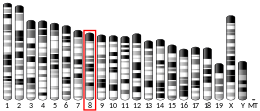VE-cadherin
Cadherin-5, or VE-cadherin (vascular endothelial cadherin), also known as CD144 (Cluster of Differentiation 144), is a type of cadherin. It is encoded by the human gene CDH5.[5]
Function
[edit]VE-cadherin is a classical cadherin from the cadherin superfamily and the gene is located in a six-cadherin cluster in a region on the long arm of chromosome 16 that is involved in loss of heterozygosity events in breast and prostate cancer. The encoded protein is a calcium-dependent cell–cell adhesion glycoprotein composed of five extracellular cadherin repeats, a transmembrane region and a highly conserved cytoplasmic tail. Functioning as a classic cadherin by imparting to cells the ability to adhere in a homophilic manner, the protein may play an important role in endothelial cell biology through control of the cohesion and organization of the intercellular junctions.[6]
Integrity of intercellular junctions is a major determinant of permeability of the endothelium, and the VE-cadherin-based adherens junction is thought to be particularly important. VE-cadherin is known to be required for maintaining a restrictive endothelial barrier – early studies using blocking antibodies to VE-cadherin increased monolayer permeability in cultured cells[7] and resulted in interstitial edema and hemorrhage in vivo.[8] A recent study has shown that TNFAIP3 (A20, a dual-ubiquitin editing enzyme) is essential for stability and expression of VE-cadherin. Deubiquitinase function of A20 was shown to remove ubiquitin chains from VE-cadherin, thereby prevented loss of VE-cadherin expression at the endothelial adherens junctions.[9]
VE-cadherin is indispensable for proper vascular development – there have been two transgenic mouse models of VE-cadherin deficiency, both embryonic lethal due to vascular defects.[10][11] Further studies using one of these models revealed that although vasculogenesis occurred, nascent vessels collapsed or disassembled in the absence of VE-cadherin.[12] Therefore, it was concluded that VE-cadherin serves the purpose of maintaining newly formed vessels.
Interactions
[edit]VE-cadherin has been shown to interact with:
- Beta-catenin[13][14]
- Plakoglobin[13][14]
- PTPRB[15]
- Catenin (cadherin-associated protein), alpha 1[13][14]
- CTNND1[16][17]
- PTPmu (PTPRM)[18]
- PTPrho (PTPRT)[19]
As a biomarker
[edit]VE-cadherin may serve as a biomarker for radiation exposure.[20]
See also
[edit]References
[edit]- ^ a b c GRCh38: Ensembl release 89: ENSG00000179776 – Ensembl, May 2017
- ^ a b c GRCm38: Ensembl release 89: ENSMUSG00000031871 – Ensembl, May 2017
- ^ "Human PubMed Reference:". National Center for Biotechnology Information, U.S. National Library of Medicine.
- ^ "Mouse PubMed Reference:". National Center for Biotechnology Information, U.S. National Library of Medicine.
- ^ Suzuki S, Sano K, Tanihara H (April 1991). "Diversity of the cadherin family: evidence for eight new cadherins in nervous tissue". Cell Regul. 2 (4): 261–70. doi:10.1091/mbc.2.4.261. PMC 361775. PMID 2059658.
- ^ "Entrez Gene: CDH5 cadherin 5, type 2, VE-cadherin (vascular epithelium)".
- ^ Corada M, Liao F, Lindgren M, Lampugnani MG, Breviario F, Frank R, Muller WA, Hicklin DJ, Bohlen P, Dejana E (March 2001). "Monoclonal antibodies directed to different regions of vascular endothelial cadherin extracellular domain affect adhesion and clustering of the protein and modulate endothelial permeability". Blood. 97 (6): 1679–84. doi:10.1182/blood.V97.6.1679. PMID 11238107.
- ^ Corada M, Zanetta L, Orsenigo F, Breviario F, Lampugnani MG, Bernasconi S, Liao F, Hicklin DJ, Bohlen P, Dejana E (August 2002). "A monoclonal antibody to vascular endothelial-cadherin inhibits tumor angiogenesis without side effects on endothelial permeability". Blood. 100 (3): 905–11. doi:10.1182/blood.V100.3.905. PMID 12130501.
- ^ Soni D, Wang DM, Regmi SC, Mittal M, Vogel SM, Schlüter D, Tiruppathi C (May 2018). "Deubiquitinase function of A20 maintains and repairs endothelial barrier after lung vascular injury". Cell Death Discovery. 4 (60): 60. doi:10.1038/s41420-018-0056-3. PMC 5955943. PMID 29796309.
- ^ Carmeliet P, Lampugnani MG, Moons L, Breviario F, Compernolle V, Bono F, Balconi G, Spagnuolo R, Oosthuyse B, Dewerchin M, Zanetti A, Angellilo A, Mattot V, Nuyens D, Lutgens E, Clotman F, de Ruiter MC, Gittenberger-de Groot A, Poelmann R, Lupu F, Herbert JM, Collen D, Dejana E (July 1999). "Targeted deficiency or cytosolic truncation of the VE-cadherin gene in mice impairs VEGF-mediated endothelial survival and angiogenesis". Cell. 98 (2): 147–57. doi:10.1016/S0092-8674(00)81010-7. PMID 10428027. S2CID 2668221.
- ^ Gory-Fauré S, Prandini MH, Pointu H, Roullot V, Pignot-Paintrand I, Vernet M, Huber P (May 1999). "Role of vascular endothelial-cadherin in vascular morphogenesis". Development. 126 (10): 2093–102. doi:10.1242/dev.126.10.2093. PMID 10207135.
- ^ Crosby CV, Fleming PA, Argraves WS, Corada M, Zanetta L, Dejana E, Drake CJ (April 2005). "VE-cadherin is not required for the formation of nascent blood vessels but acts to prevent their disassembly". Blood. 105 (7): 2771–6. doi:10.1182/blood-2004-06-2244. PMID 15604224.
- ^ a b c Lewalle JM, Bajou K, Desreux J, Mareel M, Dejana E, Noël A, Foidart JM (Dec 1997). "Alteration of interendothelial adherens junctions following tumor cell-endothelial cell interaction in vitro". Exp. Cell Res. 237 (2): 347–56. doi:10.1006/excr.1997.3799. hdl:2268/61990. PMID 9434630.
- ^ a b c Shasby DM, Ries DR, Shasby SS, Winter MC (Jun 2002). "Histamine stimulates phosphorylation of adherens junction proteins and alters their link to vimentin". Am. J. Physiol. Lung Cell Mol. Physiol. 282 (6): L1330–8. doi:10.1152/ajplung.00329.2001. PMID 12003790.
- ^ Nawroth R, Poell G, Ranft A, Kloep S, Samulowitz U, Fachinger G, Golding M, Shima DT, Deutsch U, Vestweber D (Sep 2002). "VE-PTP and VE-cadherin ectodomains interact to facilitate regulation of phosphorylation and cell contacts". EMBO J. 21 (18): 4885–95. doi:10.1093/emboj/cdf497. PMC 126293. PMID 12234928.
- ^ Ferber A, Yaen C, Sarmiento E, Martinez J (Mar 2002). "An octapeptide in the juxtamembrane domain of VE-cadherin is important for p120ctn binding and cell proliferation". Exp. Cell Res. 274 (1): 35–44. doi:10.1006/excr.2001.5436. PMID 11855855.
- ^ Lampugnani MG, Corada M, Andriopoulou P, Esser S, Risau W, Dejana E (Sep 1997). "Cell confluence regulates tyrosine phosphorylation of adherens junction components in endothelial cells". J. Cell Sci. 110 (17): 2065–77. doi:10.1242/jcs.110.17.2065. PMID 9378757.
- ^ Sui XF, Kiser TD, Hyun SW, Angelini DJ, Del Vecchio RL, Young BA, Hasday JD, Romer LH, Passaniti A, Tonks NK, Goldblum SE (2005). "Receptor protein tyrosine phosphatase micro regulates the paracellular pathway in human lung microvascular endothelia". Am J Pathol. 166 (4): 1247–58. doi:10.1016/s0002-9440(10)62343-7. PMC 1602370. PMID 15793303.
- ^ Besco JA, Hooft van Huijsduijnen R, Frostholm A, Rotter A (2006). "Intracellular substrates of brain-enriched receptor protein tyrosine phosphatase rho (RPTPrho/PTPRT)". Brain Res. 1116 (1): 50–7. doi:10.1016/j.brainres.2006.07.122. PMID 16973135. S2CID 23343123.
- ^ Hérodin F, Voir D, Vilgrain I, Courçon M, Drouet M, Boittin FX (June 2016). "Soluble Vascular Endothelial Cadherin as a New Biomarker of Irradiation in Highly Irradiated Baboons with Bone Marrow Protection". Health Physics. 110 (6): 598–605. doi:10.1097/HP.0000000000000481. PMID 27115227. S2CID 3314728.
Further reading
[edit]- Lampugnani MG, Resnati M, Raiteri M, Pigott R, Pisacane A, Houen G, Ruco LP, Dejana E (1992). "A novel endothelial-specific membrane protein is a marker of cell-cell contacts". J. Cell Biol. 118 (6): 1511–22. doi:10.1083/jcb.118.6.1511. PMC 2289607. PMID 1522121.
- Suzuki S, Sano K, Tanihara H (1991). "Diversity of the cadherin family: evidence for eight new cadherins in nervous tissue". Cell Regul. 2 (4): 261–70. doi:10.1091/mbc.2.4.261. PMC 361775. PMID 2059658.
- Breviario F, Caveda L, Corada M, Martin-Padura I, Navarro P, Golay J, Introna M, Gulino D, Lampugnani MG, Dejana E (1995). "Functional properties of human vascular endothelial cadherin (7B4/cadherin-5), an endothelium-specific cadherin". Arterioscler. Thromb. Vasc. Biol. 15 (8): 1229–39. doi:10.1161/01.ATV.15.8.1229. PMID 7627717.
- Ali J, Liao F, Martens E, Muller WA (1997). "Vascular endothelial cadherin (VE-cadherin): cloning and role in endothelial cell-cell adhesion". Microcirculation. 4 (2): 267–77. doi:10.3109/10739689709146790. PMID 9219219. S2CID 21501093.
- Lampugnani MG, Corada M, Andriopoulou P, Esser S, Risau W, Dejana E (1997). "Cell confluence regulates tyrosine phosphorylation of adherens junction components in endothelial cells". J. Cell Sci. 110 (17): 2065–77. doi:10.1242/jcs.110.17.2065. PMID 9378757.
- Lewalle JM, Bajou K, Desreux J, Mareel M, Dejana E, Noël A, Foidart JM (1998). "Alteration of interendothelial adherens junctions following tumor cell-endothelial cell interaction in vitro". Exp. Cell Res. 237 (2): 347–56. doi:10.1006/excr.1997.3799. hdl:2268/61990. PMID 9434630.
- Kremmidiotis G, Baker E, Crawford J, Eyre HJ, Nahmias J, Callen DF (1998). "Localization of human cadherin genes to chromosome regions exhibiting cancer-related loss of heterozygosity". Genomics. 49 (3): 467–71. doi:10.1006/geno.1998.5281. PMID 9615235.
- Kowalczyk AP, Navarro P, Dejana E, Bornslaeger EA, Green KJ, Kopp DS, Borgwardt JE (1998). "VE-cadherin and desmoplakin are assembled into dermal microvascular endothelial intercellular junctions: a pivotal role for plakoglobin in the recruitment of desmoplakin to intercellular junctions". J. Cell Sci. 111 (20): 3045–57. doi:10.1242/jcs.111.20.3045. PMID 9739078.
- Kawashima M, Kitagawa M (1999). "An immunohistochemical study of cadherin 5 (VE-cadherin) in vascular endothelial cells in placentas with gestosis". J. Obstet. Gynaecol. Res. 24 (6): 375–84. doi:10.1111/j.1447-0756.1998.tb00112.x. PMID 10063232. S2CID 12405995.
- Carmeliet P, Lampugnani MG, Moons L, Breviario F, Compernolle V, Bono F, Balconi G, Spagnuolo R, Oosthuyse B, Dewerchin M, Zanetti A, Angellilo A, Mattot V, Nuyens D, Lutgens E, Clotman F, de Ruiter MC, Gittenberger-de Groot A, Poelmann R, Lupu F, Herbert JM, Collen D, Dejana E (1999). "Targeted deficiency or cytosolic truncation of the VE-cadherin gene in mice impairs VEGF-mediated endothelial survival and angiogenesis". Cell. 98 (2): 147–57. doi:10.1016/S0092-8674(00)81010-7. PMID 10428027. S2CID 2668221.
- Ukropec JA, Hollinger MK, Salva SM, Woolkalis MJ (2000). "SHP2 association with VE-cadherin complexes in human endothelial cells is regulated by thrombin". J. Biol. Chem. 275 (8): 5983–6. doi:10.1074/jbc.275.8.5983. PMID 10681592.
- Shimoyama Y, Tsujimoto G, Kitajima M, Natori M (2001). "Identification of three human type-II classic cadherins and frequent heterophilic interactions between different subclasses of type-II classic cadherins". Biochem. J. 349 (Pt 1): 159–67. doi:10.1042/0264-6021:3490159. PMC 1221133. PMID 10861224.
- Shaw SK, Bamba PS, Perkins BN, Luscinskas FW (2001). "Real-time imaging of vascular endothelial-cadherin during leukocyte transmigration across endothelium". J. Immunol. 167 (4): 2323–30. doi:10.4049/jimmunol.167.4.2323. PMID 11490021.
- van Buul JD, Voermans C, van den Berg V, Anthony EC, Mul FP, van Wetering S, van der Schoot CE, Hordijk PL (2002). "Migration of human hematopoietic progenitor cells across bone marrow endothelium is regulated by vascular endothelial cadherin". J. Immunol. 168 (2): 588–96. doi:10.4049/jimmunol.168.2.588. PMID 11777950.
- Ferber A, Yaen C, Sarmiento E, Martinez J (2002). "An octapeptide in the juxtamembrane domain of VE-cadherin is important for p120ctn binding and cell proliferation". Exp. Cell Res. 274 (1): 35–44. doi:10.1006/excr.2001.5436. PMID 11855855.
- Gorlatov S, Medved L (2002). "Interaction of fibrin(ogen) with the endothelial cell receptor VE-cadherin: mapping of the receptor-binding site in the NH2-terminal portions of the fibrin beta chains". Biochemistry. 41 (12): 4107–16. doi:10.1021/bi0160314. PMID 11900554.
- Di Simone N, Castellani R, Caliandro D, Caruso A (2003). "Antiphospholid antibodies regulate the expression of trophoblast cell adhesion molecules". Fertil. Steril. 77 (4): 805–11. doi:10.1016/S0015-0282(01)03258-7. PMID 11937138.
- Zanetti A, Lampugnani MG, Balconi G, Breviario F, Corada M, Lanfrancone L, Dejana E (2002). "Vascular endothelial growth factor induces SHC association with vascular endothelial cadherin: a potential feedback mechanism to control vascular endothelial growth factor receptor-2 signaling". Arterioscler. Thromb. Vasc. Biol. 22 (4): 617–22. doi:10.1161/01.ATV.0000012268.84961.AD. PMID 11950700.
- Lampugnani MG, Zanetti A, Breviario F, Balconi G, Orsenigo F, Corada M, Spagnuolo R, Betson M, Braga V, Dejana E (2002). "VE-cadherin regulates endothelial actin activating Rac and increasing membrane association of Tiam". Mol. Biol. Cell. 13 (4): 1175–89. doi:10.1091/mbc.01-07-0368. PMC 102260. PMID 11950930.
- Vincent PA, Xiao K, Buckley KM, Kowalczyk AP (2004). "VE-cadherin: adhesion at arm's length". Am J Physiol Cell Physiol. 286 (5): C987–97. doi:10.1152/ajpcell.00522.2003. PMID 15075197.
External links
[edit]- VE-cadherin+protein,+human at the U.S. National Library of Medicine Medical Subject Headings (MeSH)
- CDH5 human gene location in the UCSC Genome Browser.
- CDH5 human gene details in the UCSC Genome Browser.
This article incorporates text from the United States National Library of Medicine, which is in the public domain.





